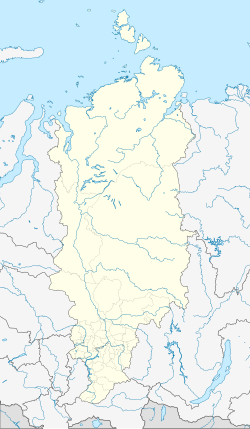Zelenogorsk (Krasnoyarsk)
| city
Zelenogorsk
Зеленогорск
|
||||||||||||||||||||||||||||||||||||||||||||
|
||||||||||||||||||||||||||||||||||||||||||||
|
||||||||||||||||||||||||||||||||||||||||||||
| List of cities in Russia | ||||||||||||||||||||||||||||||||||||||||||||
Zelenogorsk ( Russian Зеленогорск ) is a closed city with 66,056 inhabitants (as of October 14, 2010) in the Krasnoyarsk region in Russia . It is located 103 km east of the regional capital Krasnoyarsk on the banks of the Kan River . The closest towns are Saosjorny (16 km southeast), Borodino (29 km southeast) and Ujar (35 km southwest).
history
Before the city was founded, there was a village called Ust-Barga ( Усть-Барга ) on the site of today's town of Zelenogorsk , which was known since 1735 for a small iron foundry located there.
In the 1950s, the Soviet Atomic Energy Ministry decided to build a uranium enrichment facility for nuclear weapons in the Krasnoyarsk region, which is geographically distant from the European part of the country . For this purpose, a new city was built within a relatively short time from 1956 onwards, which, due to the usual secrecy of the Soviet and Russian nuclear industries, remained closed to the public from the start. The city was founded on July 18, 1956, when construction of the first residential building began here. Initially the city was codenamed Saosjorny-13 , later it was changed to Krasnoyarsk-45 .
The uranium enrichment plant, which was named Elektrochemiewerk , was put into operation in 1962. The city was essentially built according to the urban planning pattern typical of the post-war Soviet Union and therefore largely consists of multi-storey prefabricated buildings and large industrial complexes.
The existence of this city was officially confirmed only in 1992, after Boris Yeltsin announced the opening of all secret and closed cities. The city was called Krasnoyarsk-45 until 1994, when it was renamed Zelenogorsk - literally "City of Green Mountains", a place name that was relatively common in the territory of the former Soviet Union. However, access to the city is still regulated today, partly because the city's residents voted in 1996 to retain the status of a “closed city”. The city can only be entered from there by non-residents or employees with a special permit.
Population development
| year | Residents |
|---|---|
| 2002 | 69,355 |
| 2010 | 66.056 |
Note: census data
Economy and Transport
The main operation of the city is the electrochemical plant, which today produces not only nuclear weapons technology but also consumer goods such as televisions, monitors, electricity meters and plastic goods. Another important plant in Zelenogorsk is the Krasnoyarskaya GRES-2 thermal power station .
The city's former main economic activity, plutonium mining, has been completely abandoned, but the city has managed to attract other high-tech companies, such as satellite production . Around 75% of all Russian satellites are now produced in the city, as well as those for Israel, Indonesia, Ukraine and Kazakhstan, for example.
The main traffic connections between Zelenogorsk and other cities run via the nearby town of Saozjorny , where there is a station on the Trans-Siberian Railway . The R255 trunk road also runs nearby .
Further educational institutions
Zelenogorsk has a branch of the Krasnoyarsk Polytechnic University.
sons and daughters of the town
- Juri Muchin (* 1971), swimmer
- Wladislaw Aminow (* 1977), swimmer
- Arina Opjonyschewa (* 1999), swimmer
Web links
- Zelenogorsk Official Website (Russian)
- Unofficial portal zelenogorsk.ru (Russian)
- Zelenogorsk on mojgorod.ru (Russian)
- Zelenogorsk Electrochemical Plant Website (Russian)
Individual evidence
- ↑ a b Itogi Vserossijskoj perepisi naselenija 2010 goda. Tom 1. Čislennostʹ i razmeščenie naselenija (Results of the All-Russian Census 2010. Volume 1. Number and distribution of the population). Tables 5 , pp. 12-209; 11 , pp. 312–979 (download from the website of the Federal Service for State Statistics of the Russian Federation)
- ↑ a b Alastair Bonnett: The strangest places in the world . 6th edition. CH Beck, Munich 2016, ISBN 978-3-406-67492-1 , p. 60-64 .
- ↑ Vladislav Aminov in the database of Sports-Reference (English)
- ↑ Arina Opyonysheva in the database of Sports-Reference (English)



